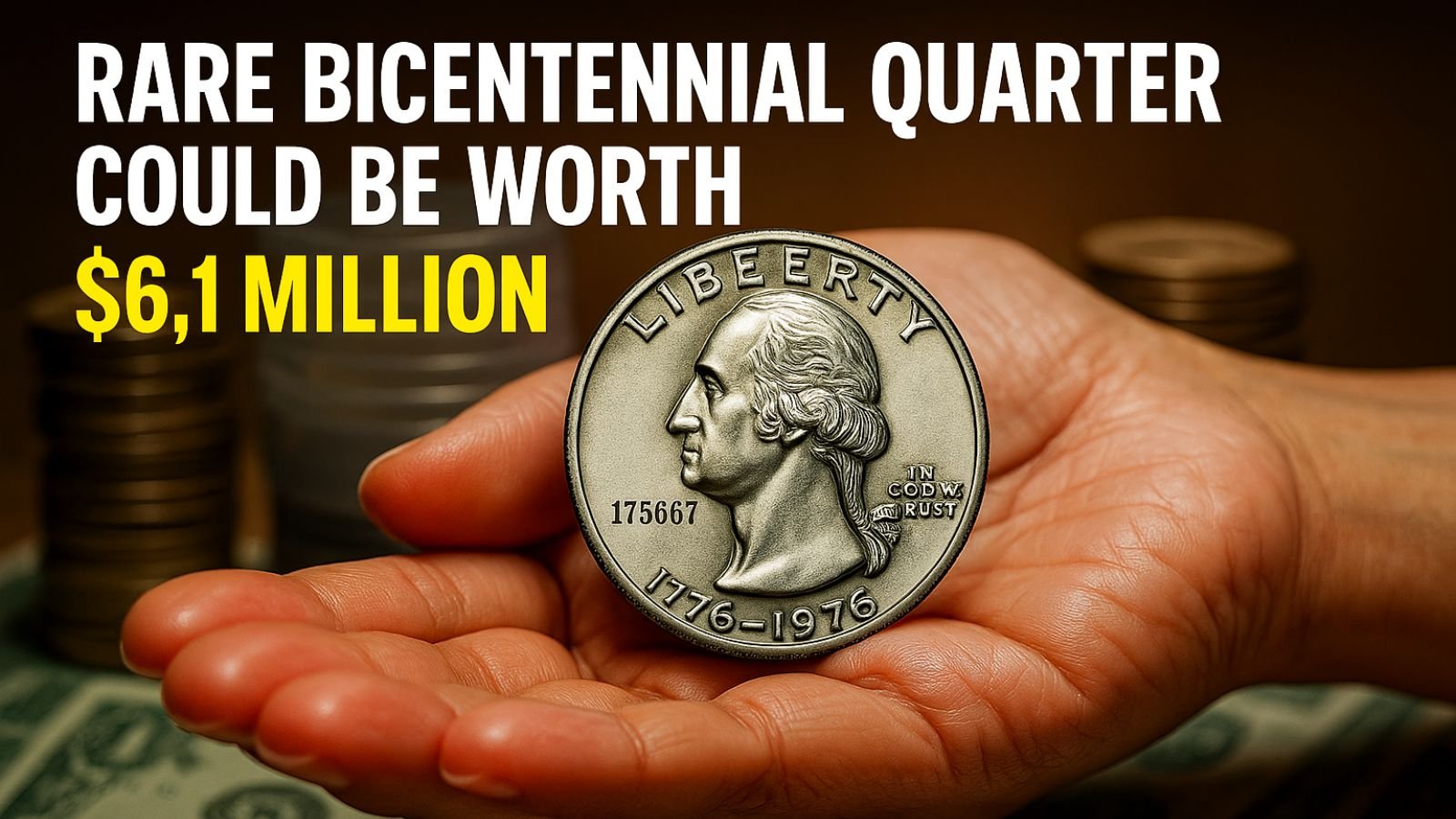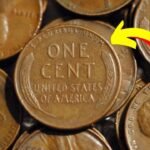Coin collecting, officially known as numismatics, has long fascinated hobbyists, historians, and treasure hunters alike. What starts as a simple interest in coins can quickly turn into a thrilling journey through history, economy, and sometimes—astonishing value. Among all the coins that have ever passed through American hands, one coin in particular has grabbed headlines and captured imaginations across the country: the Rare Bicentennial Quarter.
Believe it or not, this special quarter—once used as everyday change—could now be worth up to $6.1 million. That’s right: one single quarter, originally worth 25 cents, has reached a market value that rivals that of luxury homes or even private islands. How is that even possible? What makes the Rare Bicentennial Quarter so valuable, and more importantly, could you unknowingly have one of these historic treasures in your own pocket, purse, or coin jar?
Let’s dive deep into the story of the Rare Bicentennial Quarter and discover what makes it so extraordinary.
What Is the Rare Bicentennial Quarter?
In 1976, the United States celebrated its 200th anniversary. To mark this historic event, the U.S. Mint introduced a special edition of the Washington quarter. These quarters were distinctly different from the usual design. Rather than the standard eagle on the reverse side, the Bicentennial Quarter features a colonial drummer boy designed by artist Jack L. Ahr, with a torch encircled by 13 stars.
Instead of a single mint year, the coin displays a double date—1776–1976—commemorating two centuries of American independence.
Tens of millions of these coins were released into circulation from the Philadelphia, Denver, and San Francisco Mints. However, only a tiny fraction of them are considered valuable today. Among those, an elite few—minted in silver or struck with major minting errors—qualify as Rare Bicentennial Quarters. These are the coins that have sold for hundreds of thousands, even millions, of dollars in numismatic circles.
Why Is the Rare Bicentennial Quarter So Valuable?
1. Minting Mistakes and Composition
The vast majority of Bicentennial quarters were made from copper-nickel clad. However, a small number were accidentally struck in 90% silver. These silver versions were never intended for general circulation, which makes them highly sought after today.
Even more rare are Bicentennial quarters that feature minting errors. These include:
- Double die obverses (doubling of the image or lettering)
- Off-center strikes
- Planchet errors (where the coin is struck on the wrong metal blank)
- Missing mint marks
Such mistakes are like golden tickets for collectors. The scarcity created by these errors pushes their value far beyond face value—sometimes even into the millions.
2. Condition and Grade
Coin condition is assessed using the Sheldon Scale, which ranges from 1 to 70. A coin graded MS-67 or higher (Mint State, nearly perfect condition) is incredibly rare, especially for a circulated quarter. A Rare Bicentennial Quarter in pristine condition, showing no wear and boasting a mirror-like finish, is much more valuable than one that’s been through years of pocket change.
The now-legendary $6.1 million Bicentennial quarter achieved such a high sale price not just because of its rarity, but also because it was graded in near-flawless condition by a certified coin grading service.
3. Provenance and History
Coins with documented history—especially if they’ve passed through the hands of influential collectors or have appeared in major auctions—can command premium prices. The story behind a coin, who owned it, how it was found, and how it was preserved, all contribute to its value. The Rare Bicentennial Quarter that sold for $6.1 million had a confirmed background and was part of a prestigious collection, making it even more valuable in the eyes of collectors.
How to Identify a Rare Bicentennial Quarter
Wondering if you might be sitting on a jackpot? Here’s how to check if your quarter is a valuable one.
Step 1: Look at the Date and Design
Every Bicentennial Quarter will have:
- The dual date 1776–1976 on the front
- A reverse design featuring a colonial drummer boy with a torch and stars
This special design makes the coin easy to spot, even at a glance.
Step 2: Examine the Edge
- A standard quarter has a copper-colored edge due to its inner core.
- A silver Bicentennial Quarter will have a solid silver-colored edge.
You can also try a magnet test: Silver is not magnetic, so if your quarter sticks to a magnet, it’s likely not silver.
Step 3: Inspect the Mint Mark
Look closely near Washington’s ponytail. Mint marks indicate where the coin was struck:
- No mint mark = Philadelphia Mint
- D = Denver Mint
- S = San Francisco Mint
The silver proofs were made at the San Francisco Mint, so if your coin has an “S” mint mark and a silver edge, it may be worth something. Also, keep an eye out for missing or misaligned mint marks, which may indicate a rare mint error.
Step 4: Weigh the Coin
Use a precision digital scale. Typical copper-nickel quarters weigh 5.67 grams, while silver quarters weigh slightly more at 5.75 grams. This small difference can make a big impact on the coin’s value.
Selling a Rare Bicentennial Quarter
If you believe you’ve found a Rare Bicentennial Quarter, don’t rush to sell it at your local pawn shop. Instead, take the right steps to ensure you get top dollar.
1. Get a Professional Appraisal
Before anything else, have your coin evaluated by a trusted grading company like:
- PCGS (Professional Coin Grading Service)
- NGC (Numismatic Guaranty Company)
These services will authenticate your coin, provide a condition grade, and even encapsulate it in a tamper-proof holder.
2. Explore Selling Options
You have several avenues to choose from:
- Major Auction Houses like Heritage Auctions or Stack’s Bowers specialize in rare coins.
- Online Marketplaces such as eBay or Great Collections allow you to list your coin for bidding or direct sale.
- Local Coin Dealers can offer in-person evaluations, though they may not offer the highest price.
- Coin Shows and Conventions provide a platform for direct negotiation with serious collectors.
3. Protect Your Investment
- Store your quarter in a certified coin holder to prevent damage.
- Avoid cleaning or polishing the coin—doing so can actually decrease its value.
- Keep all paperwork and certification organized and in a safe place.
Final Thought
The idea that a small piece of metal in your change jar could be worth millions may seem far-fetched—but history has proven otherwise. The Rare Bicentennial Quarter is a perfect example of how scarcity, historical context, minting errors, and condition can align to produce an item of tremendous worth.
As coin collecting continues to gain momentum, and more people take an interest in their pocket change, these rare coins become even more desirable. Whether you’re a seasoned collector or a curious beginner, it’s always worth giving your spare change a second look. You never know what treasures might be hiding in plain sight.
So the next time you’re sorting coins, remember: that seemingly ordinary quarter with a colonial drummer could turn out to be a Rare Bicentennial Quarter worth a small fortune. Check the date. Look at the mint mark. Weigh it. Get it appraised. Who knows—you might just uncover the next million-dollar coin.
FAQs About the Rare Bicentennial Quarter
Q1: What exactly is a Rare Bicentennial Quarter?
It’s a special edition of the 1976 quarter, featuring a unique design and often struck in silver or with minting errors, making it highly valuable to collectors.
Q2: How can I tell if my Bicentennial Quarter is rare?
Look for a silver edge, unique mint marks (especially “S” or no mint mark), and check for minting errors like off-center strikes or doubled images. Weigh the coin to see if it matches silver specifications.
Q3: What’s the best way to sell a Rare Bicentennial Quarter?
Start by getting it authenticated and graded. Then consider selling through auction houses, numismatic forums, or online platforms like eBay or Great Collections.
Some Important Link
| Telegram Group | Click Here |
| WhatsApp Group | Click Here |
| Home Page | Click Here |










